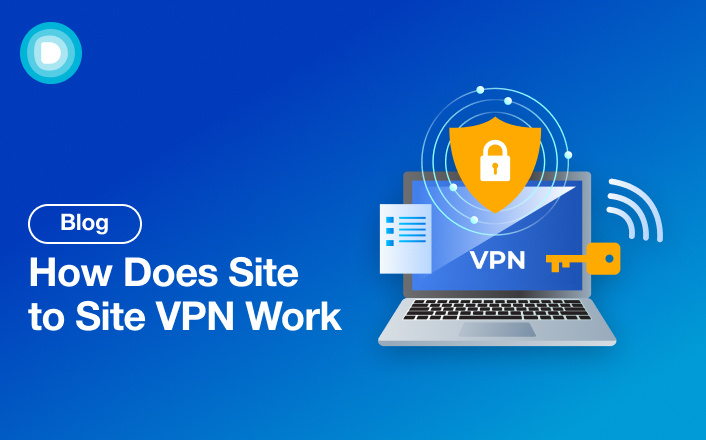- Product
-
Solution
-
By Industry
Cybersecurity solutions tailored to your industry’s needs.
-
- Resources
-
Books
Our ultimate guides and playbooks
Solution Briefs
Overview of PureDome’s functionality
-
Quizzes
Assess your cybersecurity readiness
Case Studies
PureDome customer success stories
Newsletter
Subscribe to the PureDome newsletter
-
- About Us
- Partner
- Pricing
- Download
How Does Site to Site VPN Work
-
Aiman Ikram
-
12 Jun 2024
- 3 min read

.png?width=1728&height=834&name=Feature%20image-%20How%20Does%20Site%20to%20Site%20VPN%20Work%20(2).png)
Can you imagine having a direct, private highway linking your offices, allowing for effortless data flow without the traffic jams of public internet connections? That's where site-to-site VPNs come into play.
These powerful tools not only ensure secure communication between your locations but also enhance efficiency and productivity. In this blog, we will discuss the workings of site-to-site VPNs, exploring their benefits, setup process, and why they're a critical component for modern enterprises.
Introduction to Site-to-Site VPNs
Site-to-site VPNs (Virtual Private Networks) are secure connections between different office locations of a business. They create a private tunnel over the internet, allowing offices to share data safely as if they were all in the same location. This helps businesses keep their communications secure and efficient without using public networks.
How Site-to-Site VPNs Work
Site-to-site VPNs work by creating a secure tunnel over the internet that connects different office locations. Here's a step-by-step breakdown:
- Connection Setup: Each office has a VPN gateway, which can be a router or firewall. These gateways establish a connection with each other over the internet.
- Encryption: The data traveling through this connection is encrypted, meaning it's turned into a secure code that only authorized users can decode. This keeps the data safe from hackers.
- Tunnel Creation: The VPN gateways create a "tunnel" through which the encrypted data travels. This tunnel is private and secure, protecting the data from being accessed by unauthorized users.
- Data Transmission: When an employee at one office sends data to another office, the data is encrypted by the VPN gateway, sent through the tunnel, and then decrypted by the receiving VPN gateway.
- Seamless Integration: The VPN makes it appear as if all connected offices are on the same local network, making it easy to share resources like files and applications.

Types of Site-to-Site VPNs
There are two main types of site-to-site VPNs: intranet-based and extranet-based.
Intranet-based VPNs connect multiple offices of the same company. For example, if a company has offices in different cities, an intranet-based VPN allows them to communicate and share data securely as if they were all in one location.
Extranet-based VPNs connect a company's network to the network of another organization, like a business partner or a supplier. This type of VPN ensures that both organizations can work together securely, sharing necessary data while keeping other information private.
Both types of VPNs provide secure and efficient ways to connect different networks, whether within a single company or between different organizations.
Setting Up a Site-to-Site VPN
Choose VPN Hardware and Software: Select the VPN gateways (routers or firewalls) and the VPN software that supports site-to-site VPN connections.
Configure VPN Gateways: Set up the VPN gateways at each office location with the necessary network settings, including IP addresses and security protocols.
Establish VPN Tunnel: Use the VPN software to create a secure tunnel between the VPN gateways. This involves setting up encryption and authentication methods.
Test the Connection: Once the tunnel is established, test the connection to ensure data can flow securely between the sites.
Monitor and Maintain: Regularly monitor the VPN connection for any issues and update the software and security settings as needed to maintain a secure and efficient network.
Troubleshooting and Maintenance
Monitor the VPN Connection: Regularly check the VPN to ensure it's working properly and data is flowing securely.
Update Software and Firmware: Keep the VPN hardware and software up-to-date to protect against security vulnerabilities and improve performance.
Check Network Settings: Ensure the network settings on both ends of the VPN match correctly, including IP addresses and encryption settings.
Restart VPN Gateways: If there are connection issues, try restarting the VPN gateways to reset the connection.
Review Logs: Check the VPN logs for any error messages or unusual activity that might indicate a problem.
Test the Connection: Periodically test the VPN connection to make sure it's stable and performing as expected.
Contact Support: If issues persist, contact your VPN provider's support team for assistance.
How PureDome Helps
PureDome simplifies setting up and managing site-to-site VPNs, providing an easy-to-use solution for secure and reliable connections between multiple office locations. It ensures data is encrypted and protected, offers user-friendly tools for configuration and monitoring, and provides support to quickly resolve any issues. With PureDome, businesses can maintain seamless and secure communication across their entire network.
Frequently Asked Questions
What is a site-to-site VPN?
A site-to-site VPN is a secure connection that links different office locations over the internet, creating a private network for data transmission.
What are the main benefits of using a site-to-site VPN?
The main benefits include enhanced security, improved efficiency, cost savings, and seamless communication between multiple locations.
How do I troubleshoot connection issues with my site-to-site VPN?
Check network settings, update software, restart VPN gateways, and review logs for error messages or unusual activity. If issues persist, contact your VPN provider's support team.